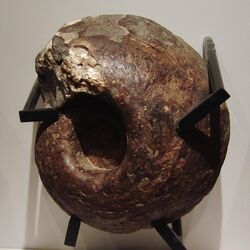Biology:Fagesia
| Fagesia | |
|---|---|

| |
| Fossil of Fagesia spheroidalis from Japan . Late Cretaceous. Exhibit in the National Museum of Nature and Science, Tokyo, Japan | |
| Scientific classification | |
| Kingdom: | Animalia
|
| Phylum: | |
| Class: | |
| Subclass: | |
| Order: | |
| Superfamily: | |
| Family: | |
| Genus: | Fagesia Pervinquière 1907
|
| Species | |
|
See text | |
Fagesia is a small, subglobular ammonite (suborder Ammonitina) belonging to the vascoceratid family of the Acanthocerataceae that lived during the Turonian stage of the Late Cretaceous, 92–88 Ma ago.
The shell of Fagesia is about 9.5 cm (3.47 in) in diameter, typically with blunt umbilical tubercles from which spring 2 or three ribs each, but which are lost in the late growth stage. The suture is ammonitic with long spikey lobes and saddles with rounded subelements.
Species
- †Fagesia catinus Mantell 1822 - Loma Gorda Formation, Colombia
- †Fagesia fleuryi Pervinquière 1907
- †Fagesia peroni Pervinquière 1907
- †Fagesia pervinquieri Bose 1920
- †Fagesia rudra Stoliczka 1865
- †Fagesia spheroidalis Pervinquière 1907
- †Fagesia superstes Kossmat 1897
- †Fagesia tevesthensis Peron 1896
Distribution
Fossils of Fagesia have been found in Brazil, Colombia (El Colegio, Cundinamarca, La Frontera (Cundinamarca, Huila and Boyacá),[1] and Loma Gorda Formations, Aipe, Huila),[2] Egypt, France, Mexico, Morocco, Nigeria, Oman, Romania, the Russian Federation, Tunisia, United States (Arizona, California, Colorado, New Mexico, Texas), and Venezuela.[3]
References
- ↑ Blanco et al., 2004, p.26
- ↑ Patarroyo, 2011
- ↑ Fagesia at Fossilworks.org
Bibliography
- Blanco, Johana Paola; Paula Andrea Medina, and Pedro Patarroyo. 2004. La Formación La Frontera, Sección Vereda Tóriba: Una propuesta para la designación del Lectoestratotipo. Geología Colombiana 29. 23-40.
- Patarroyo, Pedro. 2011. Sucesión de Amonitas del Cretácico Superior (Cenomaniano-Coniaciano) de la parte más alta de la Formación Hondita y de la Formación Loma Gorda en la Quebrada Bambucá, Aipe - Huila (Colombia). Boletín de Geología, Universidad Nacional de Colombia 33. 69-92.
Further reading
- Arkell, W.J.; Kummel, B.; Wright, C.W. (1957). Mesozoic Ammonoidea. Treatise on Invertebrate Paleontology, Part L, Mollusca 4. Lawrence, Kansas: Geological Society of America and University of Kansas Press.
Wikidata ☰ Q5429393 entry
 |

